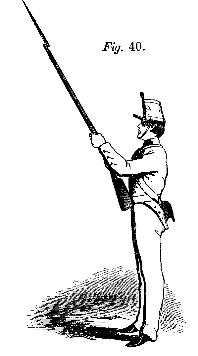Inspection of - ARMS.
One time and three motions.
First motion. Face to the right once and a half on the left heel, carrying the right foot perpendicularly to the rear of the alignment, about six inches from, and at right angles with, the left foot; seize promptly the piece with the left hand a little above the middle band, incline the muzzle to the rear without displacing the heel of the butt, the rammer turned towards the body; carry at the same time the right hand to the bayonet and seize it as has been prescribed, No.130.
Second motion. Draw the bayonet from the scabbard, carry and fix it on the muzzle; seize next the rammer, draw it as has been explained in loading it twelve times, and let it glide to the bottom of the bore.
Third motion. Face promptly to the front, seize the piece with the right hand, and retake the position of ordered arms.
The instructor will then inspect in succession the piece of each man, in passing along the front of the rank. Each, as the instructor reaches him, will raise smartly his piece with his right hand, seize it with the left between the tail-band and the feather-spring, the lock to the front, the left hand at the height of the chin, the piece opposite to the left eye (Fig. 40); the instructor will take it with the right hand at the handle, and, after inspecting it, will return it to the soldier, who will receive it back with the right hand, and replace it in the position of ordered arms.
When the instructor shall have passed him, each soldier will retake the position prescribed at the command inspection of arms, and return the rammer; after which he will face to the front.
One time and three motions.
First motion. Face to the right once and a half on the left heel, carrying the right foot perpendicularly to the rear of the alignment, about six inches from, and at right angles with, the left foot; seize promptly the piece with the left hand a little above the middle band, incline the muzzle to the rear without displacing the heel of the butt, the rammer turned towards the body; carry at the same time the right hand to the bayonet and seize it as has been prescribed, No.130.
Second motion. Draw the bayonet from the scabbard, carry and fix it on the muzzle; seize next the rammer, draw it as has been explained in loading it twelve times, and let it glide to the bottom of the bore.
Third motion. Face promptly to the front, seize the piece with the right hand, and retake the position of ordered arms.
The instructor will then inspect in succession the piece of each man, in passing along the front of the rank. Each, as the instructor reaches him, will raise smartly his piece with his right hand, seize it with the left between the tail-band and the feather-spring, the lock to the front, the left hand at the height of the chin, the piece opposite to the left eye (Fig. 40); the instructor will take it with the right hand at the handle, and, after inspecting it, will return it to the soldier, who will receive it back with the right hand, and replace it in the position of ordered arms.
When the instructor shall have passed him, each soldier will retake the position prescribed at the command inspection of arms, and return the rammer; after which he will face to the front.
(found here near number 139- http://47thva.org/gilham/article3.html#94 )
contrasts my interpretation and makes me think perhaps the lockplate is not facing front but is facing to the right, with the butt resting on the left hip. This interpretation based on the image makes sense if the instructor were to proceed down the line without making a left face to face the front of the soldier he is inspecting, but instead only stays in a straight line, receiving each piece given to him thus. However I also fail to find anything about the manner of the instructor, which leads me to ask,
What are your interpretations of this situation?






Comment